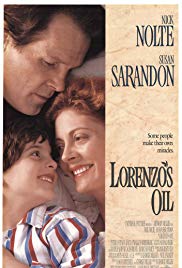For a printable version of this test suitable to distribute to a class (without suggested answers) click here. This test does not include questions about: (1) genetics (see Lesson Plan — Predicting Combinations for Alleles in a Zygote Using Punnett Squares); (2) the scientific method, see Lesson Plan — The Development of Lorenzo’s Oil, Strange Twists of Fate, and the Scientific Method); and (3) the medical ethics of clinical trials (for a short quiz on that topic click here).
1. What does the term VLCSFA stand for?
Suggested Response:
A saturated fatty acid with a very long hydrocarbon tail.
2. Focus on a single link in the hydrocarbon tail of a VLCSFA. What are the elements that make up that link and how many atoms of each element are contained in each link?
Suggested Response:
The elements are hydrogen and carbon and each link has two hydrogen atoms and one carbon atom.
3. What does the term VLCUFA stand for and how is it different than a VLCSFA? Draw a diagram showing the different linkages.
Suggested Response:
In VLCSFAs, the links in the hydrocarbon chain are made up of one carbon atom filling the four empty places in its outermost valence shell by sharing one electron with each of two hydrogen atoms and one electron each with the carbon atoms in the adjacent links of the chain. In an unsaturated fat, there is at least one link in the chain in which one carbon atom fills the empty places in its valence shell by double bonding with the carbon atom in an adjacent link. The linkages are shown in the Diagrams of Four Fatty Acids.
4. What two parts of the body are most damaged by ALD?
Suggested Response:
The white matter of the brain consisting of the myelin sheaths that surround and insulate nerve fibers and the adrenal gland.
5. What are the two sources of VLCSFAs in the body?
Suggested Response:
VLCSFAs come from food and from biosynthesis by the body itself.
6. Name and describe the part of the cell in which VLCSFAs are synthesized by the body.
Suggested Response:
The smooth endoplasmic reticulum. This is a highly convoluted membrane within cells which is responsible for the biosynthesis of proteins and lipids.
7. What are peroxisomes and what is their role in maintaining safe levels of VLCSFAs in normal people?
Suggested Response:
Peroxisomes are microbodies (organelles) within cells that contain enzymes that oxidize various chemicals in the body, including proteins and lipids. Peroxisomes in liver cells keep the level of VLCSFAs at safe levels by oxidizing excess VLCSFAs.
8. What do normal people have that ALD patients lack?
Suggested Response:
ALD patients do not have a transporter protein that moves excess VLCSFAs into the peroxisomes so that they can be degraded through oxidation. Peroxisomes in liver cells contain the enzyme that causes the oxidation of VLCSFAs.
9. Describe the model that Augusto Odone developed to show the problem of reducing VLCSFAs in Lorenzo’s body.
Suggested Response:
It is a sink with a blocked drain and two faucets. One faucet represents the VLCSFAs from food and the other represents the biosynthesis of VLCSFAs by the body. The drain represents the enzyme activity in the peroxisomes that oxidize VLCSFAs. The plug in the drain represents the failure of the body to transport the VLCSFAs to the peroxisome for destruction. In order to lower the water level (the level of VLCSFAs) both taps had to be turned off. See ALD and Lorenzo’s Oil.
10. What was the contribution of the article by the Polish chemists and where did it leave the Odones?
Suggested Response:
The paper from the Polish chemists showed that when rats were fed oleic acid their blood levels of VLCSFAs went down. The next question was “why did this occur”?
11. Explain how Lorenzo’s Oil works to prevent the buildup of VLCSFAs in the body.
Suggested Response:
It inserts so many unsaturated fatty acids into the body that only a few VLCSFAs are made.
12. In the movie, the Odones were confronted with a number of questions that they had to answer. An early question was why Lorenzo’s VLCSFA levels went up even when the VLCSFAs were eliminated from his diet. Hopefully, by looking at the sink model you know the answer. (It is that VLCSFAs were still being made by biosynthesis.) Another question the Odones had to answer was why biosynthesis of saturated fats was reduced when Lorenzo was given oleic acid, an unsaturated fat. Why did that occur?
Suggested Response:
Scientists had previously thought that the harmful VLCSFAs were produced by one enzyme and that the harmless VLCUFAs were produced by another enzyme. Augusto Odone hypothesized that one enzyme added hydrocarbon chains to both saturated fatty acids and unsaturated fatty acids. If there were only a limited number of sites at which this enzyme was located, then as the amount of unsaturated fatty acids in the body increased, the opportunity for VLCSFAs to be created would be decreased. This way of manipulating enzyme activity is called “competitive inhibition.”
13. Does Lorenzo’s Oil correct the damage done by VLCSFA’s?
Suggested Response:
No. It does not restore the myelin sheath.
14. When do symptoms of ALD appear and how many boys with the defective ALD gene will actually get the disease and show symptoms during that period?
Suggested Response:
Symptoms appear between the ages of 4 and 8. Approximately 35% of boys who have the defective gene get ALD and show symptoms at ages 4 to 8.
15. Name five symptoms of ALD.
Suggested Response:
Symptoms include (1) poor memory; (2) loss of emotional control; (3) dementia; (4) muscle weakness; (5) difficulty in walking; (6) spasticity; (7) deficiencies with hearing; (8) problems with speech; (9) problems with vision; (10) deteriorated muscle tone; (11) difficulty swallowing; and (12) coma.
16. What is the prognosis for patients with untreated ALD?
Suggested Response:
Very poor. The disease, untreated, results in increasing disability and then death.
17. What is the earliest point at which ALD can be diagnosed with modern medical techniques?
Suggested Response:
Early during pregnancy.
18. Name two current treatments for ALD.
Suggested Response:
There are four: (1) Lorenzo’s Oil (really a preventive treatment); (2) Adrenal steroid replacement therapy; (3) Bone marrow transplantation; and (4) symptomatic and supportive treatments such as physical therapy, psychological support, and special education.
19. Are excessive levels of VLCSFAs part of the cause of the deterioration of the myelin sheath in ALD sufferers or is it a mere byproduct of that process? How do we know this?
Suggested Response:
An excessive level of VLCSFAs is part of the cause of the deterioration of the myelin sheath. We know this because when VLCSFAs are kept at normal levels in asymptomatic boys with the ALD gene, the vast majority do not suffer the loss of their myelin sheath.
20. What is adrenomyeloneuropathy (AMN), how does it relate to ALD, and who gets it?
Suggested Response:
It is the adult form of ALD. It is much milder than ALD and afflicts men between the ages of 21 and 35.
21. EXTRA CREDIT: The Odones were very lucky in their effort to find a way to arrest the progress of ALD in their son. One of the reasons that the scientists were reluctant to immediately publish the remarkable drop in the level of VLCSFAs in Lorenzo’s blood was that they had no idea of what Lorenzo’s Oil would do to the human body. Focus on the different possible effects of competitive inhibition and describe a possible scenario for damage that could have been caused by the ingestion of Lorenzo’s Oil.
Suggested Response:
There is no one right response to this question. Look for scenarios which are logically possible. Examples are: (1) The enzyme process by which VLCSFAs and VLCUFAs are made could also make other compounds which are necessary for life. By crowding them all out with large amounts of unsaturated fatty acids, not only would the production of VLCSFAs be reduced but the production of these other necessary compounds could be reduced or eliminated. Lorenzo could have died or suffered a severe injury as a result. (2) The level of VLCUFAs could be driven so high that they became toxic and caused some other potentially fatal disease.





